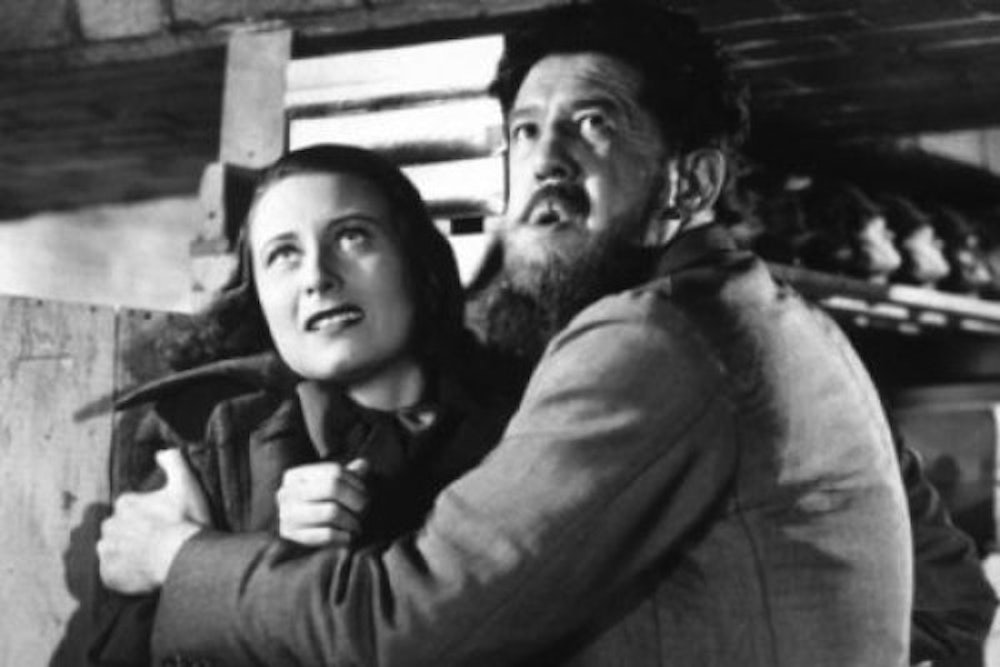As a film that neither attempts more than it can do nor is satisfied with the trivial, Port of Shadows is a pleasure. It was made in France by Marcel Carné; and apart from the thrills and satisfactions of its story, it is one of those things an occasional French film-maker does so perfectly: an atmosphere created, a mood unbroken. The scene is Le Havre under a fog, and the lower depths of town at that; but dim lighting and mean walls are not enough in themselves to establish an atmosphere, which is rather a compound of story, its meaning, its people, the scene and tempo of the action, what is said or unsaid, all in the right emphasis.
There are very few things here: a street, a shop, a few angles of the docks, the two rooms of a waterfront deadfall, abar. But these simplicities, as well as the sustained blacks, grays and 15-watt yellows of the setting, are kept from monotony by the shift of interest and the good balance of contrasts. There is even a carnival scene, its brief whirl and tinsel as sad as small carnivals always are, and therefore wholly apt to the meaning. There is aptness in costumes and sets, and the camera work which realizes them. In addition, the picture has the best use (though not recording) of dramatic sound—as opposed to the sound of pistol shots and composer’s background—that can be found anywhere outside of Hitchcock. The sad and aimless guitar player behind his empty bar; the pretty chimes on the shop door; and (best) the choir music always flooding from a radio set in the house of murder. From the guitar and the intercutting of the woman’s scream and the steamboat whistle, it is clear that M. Carne has studied Hitchcock more than casually. This is nothing against him, for while Hitchcock is the man who can teach them all on the subject of music as an active theatrical force, most of those who have studied how he did what, have neglected to study why.
Port of Shadows is a love story, one of the best. The plot is lively but soon told. An army deserter trying to skip the country; a young girl wiser if not better than she should be, trying to run away from a repulsive but pitifully amorous guardian; the presence of a nicely assorted trio of petty mobsters. The girl meets the soldier, both creatures of knocks and bruises, mutually suspicious at first, and then presently, why not? In less than forty-eight hours the different forces have got mixed up, and write your own conclusion. The conclusion of the picture is that there is a little kindness in the world—not enough to go around and never where you would expect to find it—too often unrecognized, but genuine, and when felt assuch, beautiful to see: the silly stumblebum, the host of the ginmill, the suicidal painter. The beauty of this picture is partly in this quiet statement of non-spectacular truth, but even more in the steadfast allegiance of each character to his own strength and weakness (no Wallace Beery evil whiskers and heart of gold no Victor McLaglen transformation). When goodness gets to this surface, it has been a pitched battle, and worth it Because virtue did not triumph by some flick of the wrist in the scenario department, the majority will find the picture depressing—though with the world as it is, you’d think any story proving there is virtue in it at all would be a token of joy and welcome. Times change, as it is only right they should, but I will take this treatment of love as the sudden hope of heaven, between a roughened man and a scared young woman, before any Romeos or Juliets, even at played in double exposure by Orson Welles.
But the perception and craftsman’s skill of story and direction would not be the same without the final eloquence of this group of players, each filling his part and none ambitious to swell beyond it: the occasionals, the character people and the principals. There were Delmont, Aimois, Genin; there was Pierre Brasseur in a difficult mixture of fear and tough bravado; and there was Michel Simon, who managed many effects without giving away to the audience what all concerned suspected him of. As the girl, Michele Morgan was both lovely and secure in the meaning of the part, a little too old for the given age, but one of the few who could establish the fact that a death for love might not be so fantastic after all. The picture’s mainspring is of course Jean Gabin, who is a true stalwart—indeed, it would be difficult to imagine the effect of this picture if he had not been there through all its minutes with his projection of strength in immobility, his command of the illusion that crossing a room even to get to the men’s room has its meaning and that if he kicks a dog it will be because he loves the mutt. There is something we know no more about than magnets, some inner command, some emanation of qualities that would be destroyed if talked about. There is a feeling of dignity that is more than his own—the dignity of all men—who are after all men and have dignity in some decree whether their surface foibles make fools of them or not. Gabin and all the qualities of the film around him have that perfect eloquence of the thing as perceived, marked down and brought across to all who have an interest in and hope for the processes of life, as lived.
